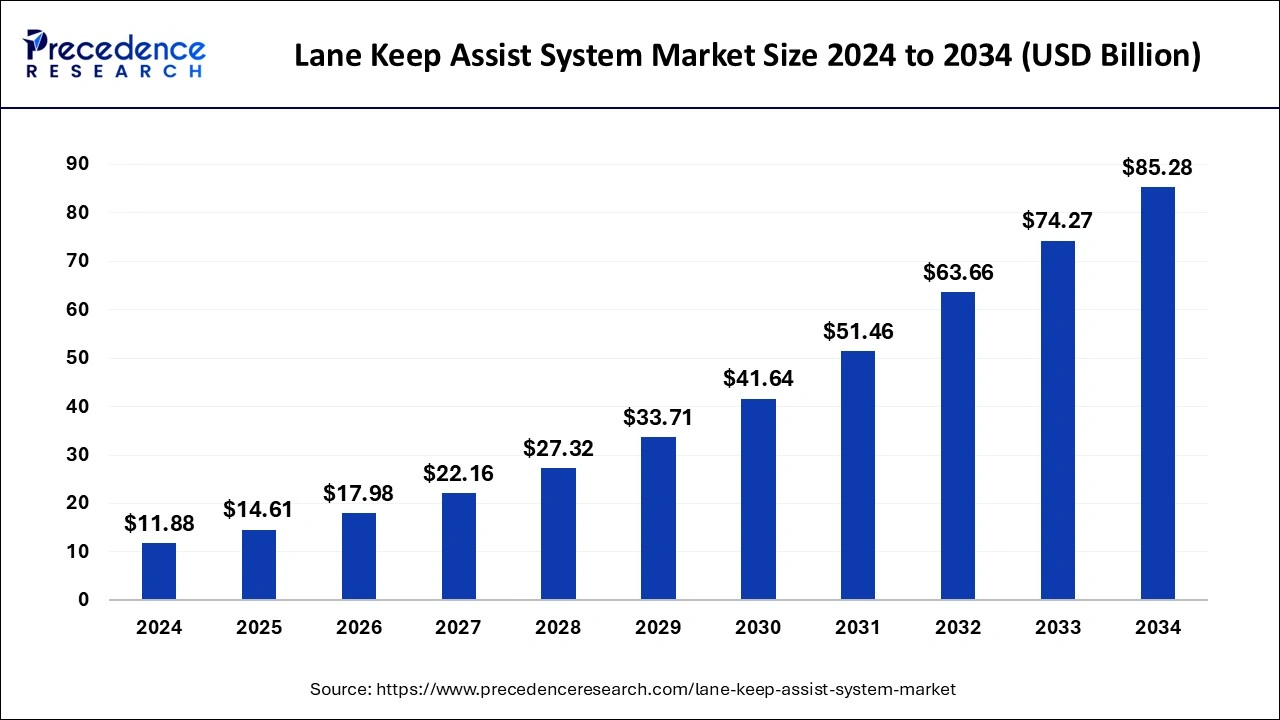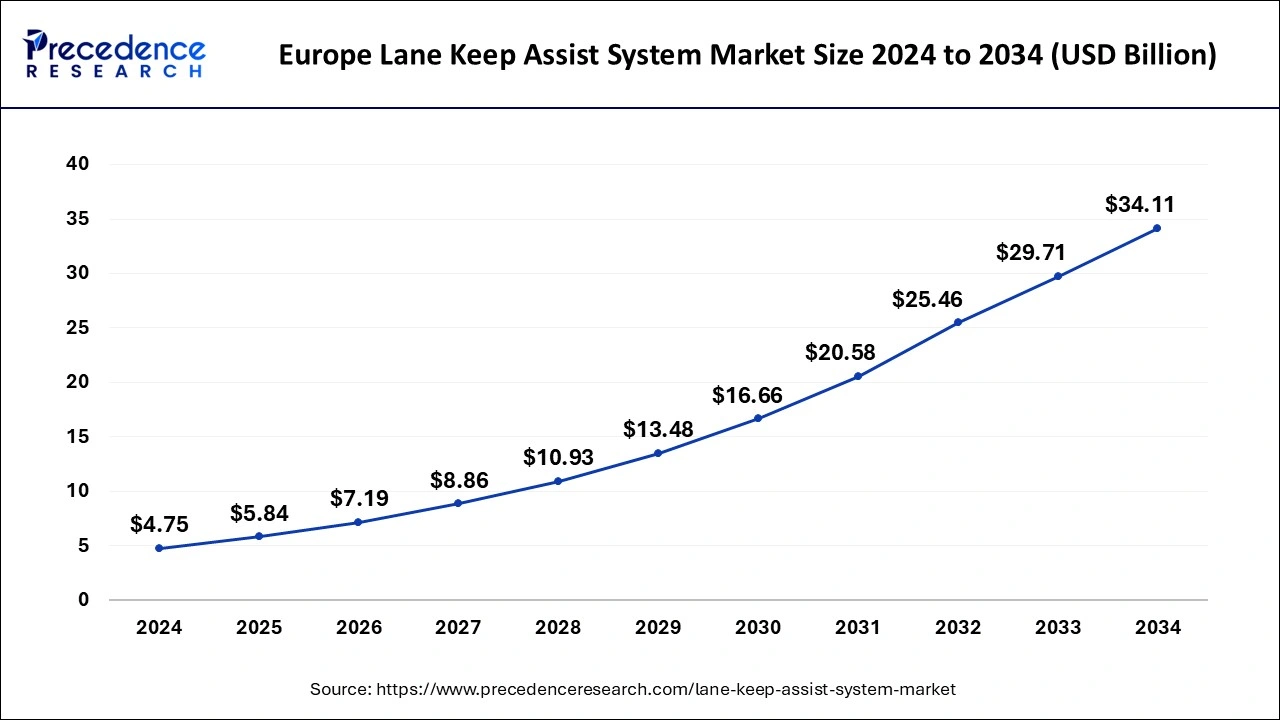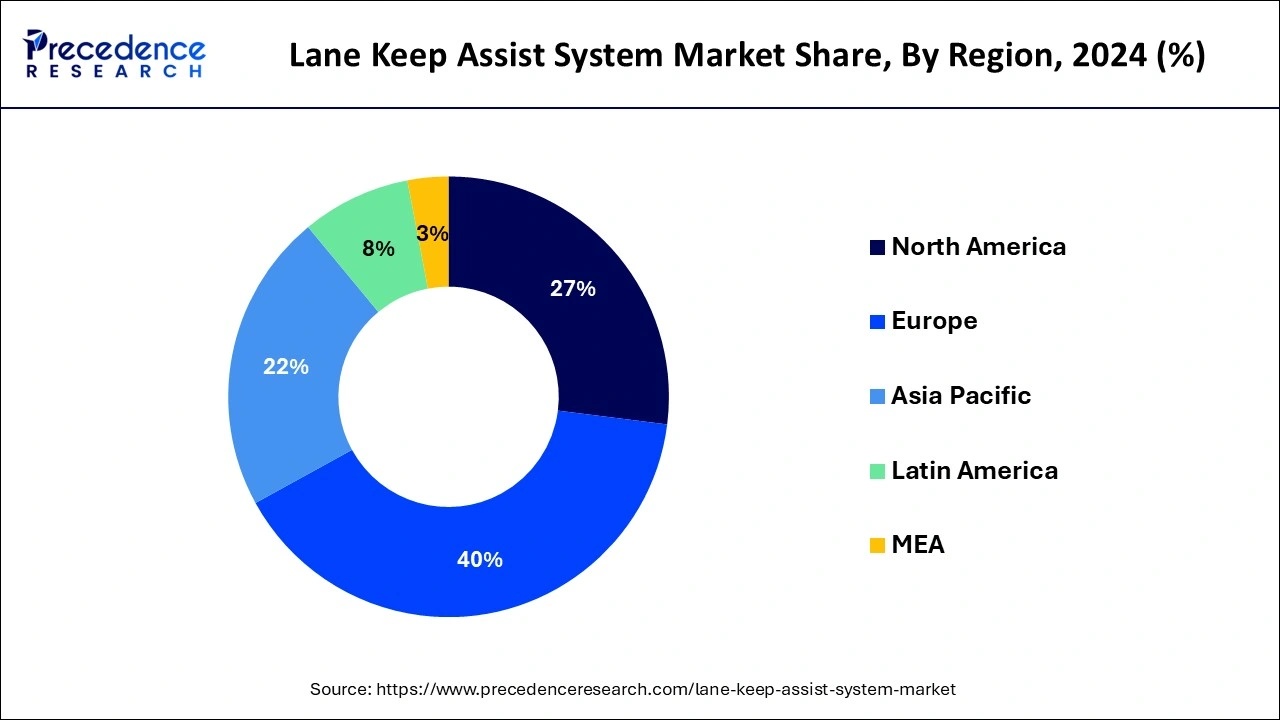List of Contents
Lane Keep Assist System Market Size and Forecast 2025 to 2034
The global lane keep assist system market size accounted for USD 11.88 billion in 2024 and is expected to exceed around USD 85.28 billion by 2034, growing at a CAGR of 21.79% from 2025 to 2034. The growing adoption of automobiles, increasing consumer inclination towards safety features, rapid technological innovation, and rising investment in building sophisticated road infrastructure is expected to drive the growth of the lane keep assist system market during the forecast period.

Lane Keep Assist System Market Key Takeaways
- Europe dominated the global market with the largest market share of 40% in 2024.
- Asia Pacific is projected to expand at the notable CAGR during the forecast period.
- By function type, the lane keeping system segment has held the largest market share in 2024.
- By function type, the lane departure warning segments is estimated to be the fastest-growing segment during the forecast period.
Integration of Artificial Intelligence for Vehicle Safety and Lane Assist Systems
As technology continues to advance rapidly, the integration of Artificial intelligence (AI) is likely to significantly the lane keep assist systems in the coming years. Artificial intelligence enhances the accuracy of maintaining the vehicle's position within the lane. Artificial Intelligence (AI) uses advanced sensors and cameras to accurately detect lane markings on the road. If anytime the vehicle drifts out of its lane, the system automatically steers it back into the appropriate or correct position. AI can monitor lane markings and assist in keeping the vehicle centered in its lane. By leveraging the power of AI in lane keep assist system helps the vehicles to maintain lane discipline throughout the journey.
Europe Lane Keep Assist System Market Size and Growth 2025 to 2034
The Europe lane keep assist system market size was evaluated at USD 4.75 billion in 2024 and is projected to be worth around USD 34.11 billion by 2034, growing at a CAGR of 21.78% from 2025 to 2034.

Europe dominated the lane keep assist system market in 2024. This is attributed to the rigorous standards governing automobile safety as well as technological developments in the field of automotive and automation sectors. This is primarily because of its significant presence in unconventional oil reserves as well as the widespread acceptance of hydraulic fracturing to extract it. Tight oil, found in low-permeability rock formations, depends heavily on hydraulic fracturing for efficient extraction, requiring the expansion of this market segment. European Union regulations ensure the inclusion of advanced driver-assistance systems (ADAS), which includes lane keep assist, in all new vehicles. This regulatory environment drives the need for these systems.

Asia-Pacific, on the other hand, is expected to develop at the fastest rate during the forecast period. This is due to rising safety standards and improved road infrastructure that aids the performance of the lane keep assist systems.
Asia-Pacific is the fastest growing in the lane keep assist system market during the forecast period. This is mainly driven by increasing vehicle production, growing road safety concerns, as well as favorable government initiatives. Increasing knowledge of road accidents and fatalities is encouraging governments and users to prioritize safety features in vehicles. The region is an essential hub for vehicle production, leading to a higher volume of vehicles equipped with advanced safety technologies such as lane-keep assist systems.
Market Overview
The lane keep assist system assists the driver by keeping the automobile in the center of the lane throughout the whole speed range. By assisting the driver with his lateral control task, the device attempts to improve comfort. It necessitates the driver's maintaining his grip on the steering wheel. The lane keep assist systems can be used in conjunction with adaptive cruise control to provide both lateral and longitudinal control. The driver can readily override the system at any time.
The current lane departure warning system aid technology evolved into the lane keeping assist system. Both systems use camera systems mounted behind the glass to monitor the road markings. This relieves stress on the car driver while also providing information on the vehicle's driving status. To keep the car in the middle of the lane, a setup that prioritizes convenience generates torque forces on each side of the lane centerline. A setup that prioritizes safety, on the other hand, waits until the vehicle is near to the lane markers before intervening. A substantially stronger steering support torque is applied in this instance. In the sense of lane departure warning systems, this can also serve as a tactile warning.
Lane Keep Assist System Market Growth Factors
- The rise in safety and security concerns along with the increasing awareness of modern driver assistance systems installed in vehicles are expected to promote the growth of the market during the forecast period.
- The rising adoption of autonomous features to enhance overall vehicle safety is anticipated to accelerate the market's revenue during the forecast period.
- The implementation of stringent traffic regulations and rising consumer preference for vehicles equipped with advanced safety systems are expected to contribute to the overall growth of the lane keep assist system market during the forecast period.
- The rising regulatory pressures for enhanced vehicle safety features are encouraging automakers to integrate these technologically advanced systems into their standard offerings, significantly fueling the growth of the market during the forecast period.
- The rise of electric vehicles (EVs) and autonomous vehicles is anticipated to boost the growth of the market in the coming years, as these vehicles demand advanced driver assistance systems (ADAS) for improving vehicle safety and enhance automation.
MarketScope
| Report Coverage | Details |
| Market Size in 2025 | USD 14.61 Billion |
| Market Size in 2034 | USD 85.28 Billion |
| Base Year | 2024 |
| Growth Rate from 2025 to 2034 | CAGR of 21.79% |
| Largest Market | Europe |
| Fastest Growing Market | Asia Pacific |
| Forecast Period | 2025 to 2034 |
| Segments Covered | Function Type, Component, Vehicle Type, Distribution Channel, and Regions |
| Regions Covered | North America, Europe, Asia-Pacific, Latin America, and Middle East & Africa |
Market Dynamics
Drivers
Growing sales of automobiles
The growing sales of automobiles are expected to drive the demand for the lane keep assist system and are expected to boost the growth of the market during the forecast period. The lane keep assist system has enhanced infrastructure and provides a wide range of safety characteristics to automobiles. The lane keep assist system is capable of assisting the driver in staying within a lane, whereas the lane departure warning system is a simple warning system intended to tell the driver via sensory means such as vision and touch if the vehicle crosses a lane marking. It combines the functions of a conventional system and a warning system.
Typically, the technology aids the driver by providing computerized steering assistance. These systems provide real-time feedback to the driver when the vehicle is drifting from a particular lane, and there is a risk of collision or dangerous to do so. In addition, technology providers and automakers are heavily investing in research and development to enhance the reliability, performance, and integration of LKAS into vehicles. These innovations help to cater to the evolving consumer preferences for safer and more convenient driving solutions.
Restraint
Lack of proper infrastructure
The lack of proper infrastructure particularly in middle- and lower-income countries is anticipated to projected to hamper the growth of the market. In addition, inadequate charging infrastructure and lack of awareness among consumers are likely to limit the expansion of the global lane keep assist system market.
Opportunity
Rising focus on minimizing road accident
The rise in the number of road accidents is projected to offer lucrative growth opportunities to the lane keep assist system market during the forecast period. Several governments around the world have implemented various stringent regulations to promote the safety of vehicle of passengers and vehicles with the intent to minimize road accidents. The lane keep assist system (LKAS) uses advanced sensors, cameras, and AI technologies to provide real-time information and correct the vehicle's position to help the driver get back in the lane. Such factors are driving the growth of the market in the coming years.
Function Type Insights
The lane-keeping system segment accounted for the dominating share in 2024 and is projected to continue its dominance over the forecast period. When an automobile approaches or crosses lane dividers, lane keeping systems use forward-facing cameras to monitor the lane lines around your vehicle and deliver visual, auditory, and tactile signals such as seat vibration and steering wheel to inform the driver. On the other hand, the lane departure warning segment is observed to grow at a rapid pace in the global lane keep assist system market over the forecast period. The lane departure warning systems alert the driver if the vehicle drifts out of its travel lane or if it leaves a defined lane without utilizing the indication.
Component Insights
The vision sensor/camera segment held the largest market share in 2024. The growth of the segment is majorly driven by the increasing use of vision sensors/cameras in detecting and monitoring lane markings. It also assists in keeping the vehicle's position relative to the road, providing the useful insights required for the system to function efficiently. On the other hand, the electronic power-assisted steering (EPAS) actuator segment is expected to grow notably. The EPAS (Electric Power Assisted Steering) Actuator assists in adjusting the physical steering to keep the vehicle in its lane.
Vehicle Type Insights
The passenger vehicles segment accounted for the highest revenue share in 2024 and is anticipated to grow at a robust CAGR over the forecast period. Passenger vehicles are increasingly equipped with the advanced lane keep assist system as a standard feature to enhance convenience, safety, and comfort. The adoption rate
of passenger vehicles with LKAS features has significantly increased due to the growing consumer demand for advanced safety features, minimizing accidents, and regulatory requirements.
According to the Society of Indian Automobile Manufacturers (SIAM), the total production of passenger vehicles, commercial vehicles, three-wheelers, two-wheelers, and quadricycle in April 2023 - March 2024 was 2,84,34,742 units. Passenger vehicle sales were 42,18,746 units in April – March 2024. In addition, several advancements including driver assistance systems like lane keeping assist systems, automated cruise control, and other vehicle technology are expected to boost the demand for passenger vehicles worldwide. From April 2022 to March 2023, passenger vehicle exports increased from 5,77,875 to 6,62,891 units.
On the other hand, the commercial vehicles segment is expected to grow at the fastest rate during the forecast period of 2025 to 2034. The segment's growth is majorly driven by the rising demand for trucks and buses with LKAS features. Commercial vehicles usually operate for longer hours and cover large distances, the use of lane-keeping assistance assists in preventing road, improving safety, and reducing driver fatigue.
Electric Vehicle Type Insights
The BEV segment recorded the highest market share in 2024. The segment's growth is attributed to the increasing integration of sophisticated safety systems in electric vehicles. The lane keep assist system is widely used in Battery Electric Vehicle (BEV), it uses advanced sensors, cameras, and other technology to detect lane markings in front of the vehicle, monitor vehicle position, initiate warning in case the vehicle starts to drift out of its lane, and corrects the vehicle's position to assist the driver to get back in the lane. Such factors are driving the growth ofthe segment in the coming years.
The FCEV segment is the fastest growing in the lane keep assist system market during the forecast period. Due to factors such as stricter emission regulations and rising awareness of zero-emission vehicles, the lane keep assist system market is mainly driven by the wider adoption of electric vehicles (EVs) as well as semi-autonomous driving features. FCEVs are gaining traction because of environmental concerns along with government incentives, but they still represent a smaller section of the overall automotive market compared to battery electric vehicles.
Lane Keep Assist System Market Companies
- ZF Friedrichshafen AG
- Denso Corporation
- Gentex Corporation
- Robert Bosch GmbH
- Continental AG
- Sensata Technologies Inc.
- Magna International Inc.
- Panasonic Corporation
- Visteon Corporation
- Hitachi Ltd.
Segments Covered in the Report
By Function Type
- Lane Keeping System
- Lane Departure Warning
By Component
- Vision Sensor/Camera
- Electronic Power-Assisted Steering (EPAS) Actuator
- Electronic Control Unit
- Others
By Vehicle Type
- Passenger Vehicles
- Commercial Vehicles
By Electric Vehicle Type
- BEV
- HEV
- PHEV
- FCEV
By Region
- North America
- Europe
- Asia-Pacific
- Latin America
- Middle East and Africa
For inquiries regarding discounts, bulk purchases, or customization requests, please contact us at sales@precedenceresearch.com
Frequently Asked Questions
Ask For Sample
No cookie-cutter, only authentic analysis – take the 1st step to become a Precedence Research client